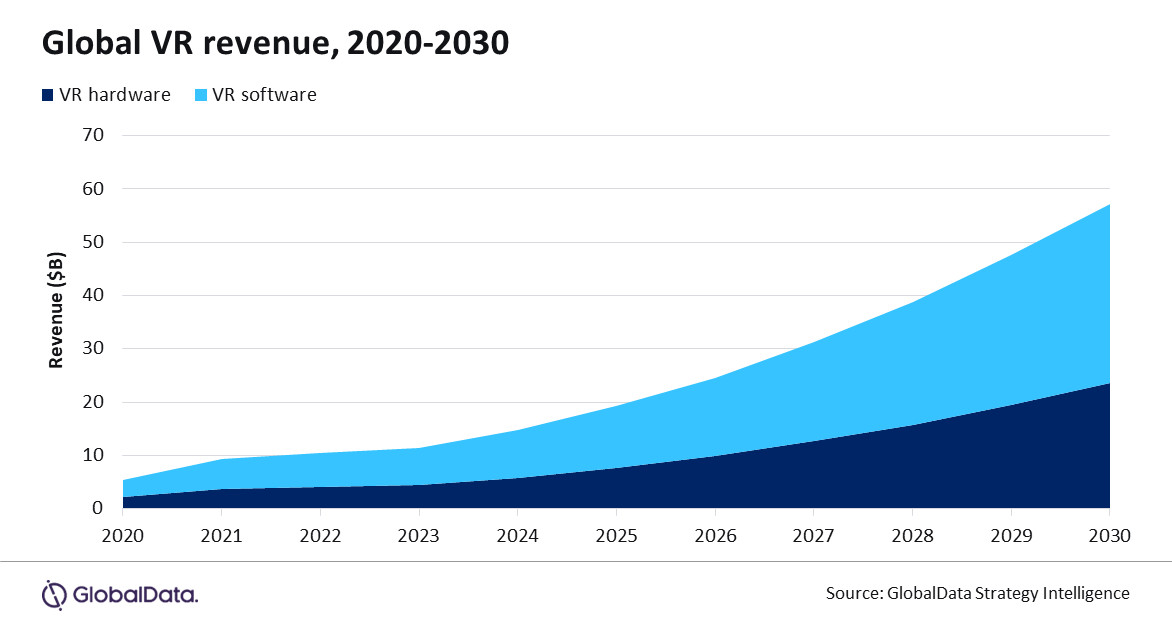How will the virtual reality market grow to be worth $57 billion by 2030 and reshape education around the world?

Victoria d’Este
Posted: Oct 25, 2024 12:30 PM Updated: Oct 25, 2024 11:34 AM

Correction and fact check date: October 25, 2024, 12:30 p.m.
briefly
Despite potential barriers to mainstream acceptance, GlobalData predicts that the global VR industry will grow at a CAGR of 26% to reach $57 billion by 2030.

According to GlobalData’s latest forecast, the global VR industry is expected to grow significantly from $11 billion in 2023 to $57 billion in 2030, despite obstacles that may hinder mainstream adoption. This expansion represents a compound annual growth rate (CAGR) of 26% over the period. In this changing environment, stakeholders must understand the dynamics of this expansion, what is impacting it, and what challenges lie ahead.
Market Dynamics: Software and Hardware Growth
A variety of reasons are driving the expansion of the virtual reality industry, including technological advancements, falling prices, and changing customer tastes. According to GlobalData’s Strategic Intelligence study, VR hardware’s share of sales is expected to increase from 39% to 41%, while VR software’s share of sales is expected to decrease significantly from 61% in 2023 to 59% in 2030. This change places greater emphasis on hardware as VR becomes more widespread.

The production of increasingly immersive experiences and advances in content creation technologies are driving the demand for VR software. As developers improve the quality and engagement of their applications, users are expected to become increasingly engaged with VR. Additionally, the decline in VR headset hardware costs is expected to attract more customers and expand adoption.
The Rise of Mixed Reality
The shift to mixed reality (MR), a hybrid technology that brings virtual items into the real world, is an interesting trend in the VR space. VR hardware manufacturers are finding this shift increasingly attractive as they look to expand their product lines. Initially focusing only on VR headsets, companies such as HTC, Meta, and Pico began examining MR solutions. For example, HTC’s Vive Focus 3, which launched in 2022, is a standalone MR headset, while Meta is working to add MR functionality to its headset lineup.
This trend is most evident in Apple’s Vision Pro, which is expected to be released in early 2024 and shows how the industry will move forward with MR technology. Opportunities in a variety of industries, including design, education, and healthcare, are presented by MR’s ability to integrate digital and physical environments. Layering digital capabilities onto the physical environment can improve user experiences, processes, and increase engagement in a variety of areas.
Overcoming Adoption Obstacles
Although the VR industry is expected to grow, there are still many obstacles standing in its way. The price of VR headsets, which typically range from $200 to $1,000, is one of the biggest obstacles. Many potential users may not be able to afford the high-performance equipment needed, especially for tethered headsets.
Another area of research is health issues related to expanded use of VR. Motion sickness, headaches and eyestrain are among the problems users experience, which can demotivate potential consumers. For VR to be successful in the long term, these health concerns must be addressed through better user experience and design. This may require creating more comfortable, lighter headsets and improving software to reduce user pain.
Essential components of the content ecosystem
Creating engaging and diverse virtual reality materials is essential to the success of the technology. Although several notable VR experiences have captured the attention of audiences, it remains difficult to build a robust content ecosystem that produces top-notch experiences on a regular basis. Lack of variety of uses and experiences can limit the appeal of VR technology and hinder its development.
If content creators want their VR business to thrive, they need to focus on creating engaging experiences that capture users’ attention. This involves examining a variety of genres, from entertainment and gaming to education and training. The more developers enter the virtual reality field and try out creative materials, the more likely they are to build a thriving ecosystem.
Stakeholder strategic considerations
The global VR industry is expected to reach $57 billion by 2030, so players need to keep a close eye on the changing situation and adapt. Companies producing VR software and devices need to think carefully about their approach. To take advantage of the new prospects, some may decide to focus on improving VR technology, while others may decide to switch to MR.
Companies must spend money on research and development to offer new products that meet consumers’ changing needs. We can also support the expansion of our diverse content ecosystem by collaborating with developers and content creators to ensure consumers have access to engaging experiences.
The future of virtual reality
The global virtual reality market forecast points to a bright future characterized by substantial expansion and innovation. Although there are challenges to cost, health and content creation, technological developments and changing customer tastes provide a positive environment for the sector.
As VR technology advances, stakeholders must continue to take the lead in addressing these challenges and capitalize on opportunities to reach larger audiences. The shift to mixed reality could also be important in determining how the VR industry develops in the future, providing new opportunities for expansion and interaction.
In conclusion, reaching a $57 billion global VR industry by 2030 will require collaboration, creativity, and a deep understanding of market dynamics. Realizing the full potential of virtual reality technology will depend on the industry’s continued efforts to develop and disrupt immersive experiences. obstacle.
disclaimer
In accordance with the Trust Project Guidelines, the information provided on these pages is not intended and should not be construed as legal, tax, investment, financial or any other form of advice. It is important to invest only what you can afford to lose and, when in doubt, seek independent financial advice. Please refer to the Terms of Use as well as the help and support pages provided by the publisher or advertiser for more information. Although MetaversePost is committed to accurate and unbiased reporting, market conditions may change without notice.
About the author
Victoria is a writer covering a variety of technology topics, including Web3.0, AI, and cryptocurrency. Her extensive experience allows her to write insightful articles for a wider audience.
more articles

Victoria d’Este

Victoria is a writer covering a variety of technology topics, including Web3.0, AI, and cryptocurrency. Her extensive experience allows her to write insightful articles for a wider audience.


